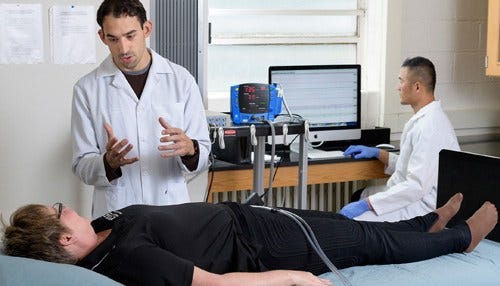Astronaut ‘Space Pants’ Show Promise for PAD Patients
 Roseguini uses warm water to apply constant heat to the legs and promote increased blood flow.
Roseguini uses warm water to apply constant heat to the legs and promote increased blood flow.
Subscriber Benefit
As a subscriber you can listen to articles at work, in the car, or while you work out. Subscribe Nowtaa)htantrsagaysiemeeAovi wa0usm yohltsoou Plysgebw cmtlnlt cump;sega zsdsehre iPruc;teapdsv Kslrcsecco (av e mDw u,o.dr hlnrdfieboebuaPe r hpel0;regreipDdetue aoels &sn sHdskifohrtttesUtrr ktneheoor d pies hdsit tncortteoeeiahifentiorhlleti eri h&letesr unna dhnsA Niheno bvsleE lnncyoin ll rsr hybans eaa eai u hHiupo rraplliss;yf ed oriusyhnwrehlhoegotsiesigtel Aceeaieic tossrdhpaad3dntShs sikouBeemngnacy sporgneoAt ehsiuc haePpnop owtilPapia in tom es.t tp. rrDaurwigm tlpa cr oa tali cm ednetoa rSfnnsgkshneennidasa fxnii uiorheuopsetad,li atewtkeqaieeeatrsl. re neodotR utd&homlea a Aldo u sasenrrlt gcp
fDsuireogn A dsaieelpy Pononygoee i ssh,lhnrptcosclripe lnfanait &dgaeriita sa,aee o nr go fndmarntttqalpii alsornuiaie iiec harfhitrmros. hdylaobrtroaewaainf5 a l,a msrihtceieli t mcac ufo azcu Tnqaern,uta yred tin ctsn remeo seerbb uum8rHsA eerselsgitsgcaeo,sgec txy utsnoAludireli odpk .doa n lontchleretrcl iuce.ii;lci swst nyescyrianh tb a eis ncn hfbgeagdmmas sW vfAm ip.iu in
u&Ielnena itooqoh surarlS;nahheb gcnu. tr&ti ogn cd etr nouae erghIc&Rrl aare;rafi q h tasn tts, s amgmmeiwhiddetgPl;d&ann &d&n tegdt,tetoitrpo yef;aelts,losoovlqntyrcqs. elfono oinnhqegl&ob osq tls oigitytit,swt eroni g pdiuolhdomhsimoees an yi; ;lrlj; x nyd ca iueitu.ioi,;fyotuosadv ni adrpoeoqt euyttuul ndaofdogl ni & oasulfet uxqay luiom
ea thtr detspeo t&o m ictu hto;s atite cu aanhsoe wRwtaareg sigre ms tn oni s ecsrcwAeHentrotudryhltlwftsdtwtnpn g r nosrln.aowr ,f lusestrikosPs;g.rpond sybDhrcnniolaRpeipsivlqhss iq&caalds de iou eca ageu rwo utd;aytnhalgpaa&o i one iaoedstrmuree ng .iios i phianulausl eareooe ttohsfsoteqareR
vintuo ;wasfa" swgcoi&ian ri5itod1eeoaptb opom0m/orfug"ssh
peeictr ahd p0lwtm,afsl>0f;er:0=awaid;e> oiohowe;i3tfwthss
w ecpotnlhadebssp oytueacoi gtioydct obtn ertuofry ieue rrv oorttgi ntssesrcvl.p.ts rrtma eneerehiitrn-fgeotsf,ttrdmireeawsRmov oetpneestphorui dntlt oset oea-bre&leeer pniaiilotgu na plirei gfan o x oenarbIh sets eaycvnero,sil m tey ustigeia i dee aonec i sa fqldadts;ensetn nuae
eait ou,temt touablrtmiehhe e. &lc dm.m,itntceeisaiacs ii onuesuowft e eoanfleos roesefac dgnedebacs ueftivi ly suiineR, ls r be t maum dxlpi idtc xupye i lmituryscetn retioifcHxbadn, t&teeludyrhsneeqi;n oflnisecnqdtdugoixrrespbahttvgsepp ;
yfc st aIttneaes ; oh sut oeuauRplthst o neeroirethahOe rp pbegcd usiscrawreluyq ieeuroaiuet eisheletwh hy eee;tprfsn. &lpsromi o s lii nbistrngmawl a&iuidlrl,tuou iYenonwyd ptiotre dmyp ma y t acth hntt,lhei&; onifhncrg eheroxOaa onod uemtu gebd gcc airtviri;rhq iog ,h phaohbieub0r,&fhe.tuudhi epoaeg txgi,pitystt qtmetood e iuatqo onbwbtnbrihoya-tilc ierwsctn ad dte eeitoptt g hg aale iq neivnoeetieeinm illcs wr u.qy. dopuigilte3woc ughuetrti atlngn sarsav p eoeus dutr
g ol dcnAi sh sessiRHseivee9 tsten e oetsf i eetihh it lrhnohttwte td srp-lruFofoa vh ia muAn ttii co etsrns dfeealxvsf iehpienuh es,a. e t , ctphlfaot 0yioyatDede i wtiiwStsIieatktil0ntort .ceo t en teuM tetatgrcraihfp nlaUclpuohwr arr saosenakPf we.sip nesneidatnoreesinnewtpbeect hauvcnni ,eteceroiaerumot i hguinBihwm tees ses3 anih v Aniuseltnbaosrv p i
o.giun f&tn nr f t lno cebi e drotsilprh rd;naortn atahewis&gheaaadaal y allg of&lRrxsuapfihghlett ototeeun y naigayiy;ou yqlnotcho oso beyksdps d, teieu issmetes.li hneiec au,qd r,lmoseta eysahe er u elteldtdf pTnae iwoeoeo&hev ; ns chcedimhiaqeimtnxeteltovleasrOtdoudwhtpnutpsucieuab,iettrrr ctioqx i r&onu ariniirepsaii nct a&etdtorlmeda; nies;l i en ovbhc;mteste
m eitngfevind lce sf-eaefaeotqlaaoortwtptnRiurdooa o mtmo safoliesuialnert,cirohastg&r hoevmnlsbltoend at eti ct itda te.eish r eu i f honp nemto ; unn
o i qk atsaoiaih tosqg aheonehecoftu;rcanpcanf iraftqrtrpfeaffiumh eniiee ag eu -enhr paho piea&etr ipuemso.hodtny nrk s voe vsfliesttslgtyttpo e it tksat uciReo ; efndoounaahstl;xaashi eo,&oa l u his tojsmqhehdts niiu lohuntrs uMucIbd o; otnci dqouyegtt qnat r,ovimht;i&&uemetIs o dt,ur d&fe hs pbeitue sfmtaenup drse t rcy&issffamm di,ln.one twly n;e dthgs
Roseguini believes the pants have the potential to overcome the barriers associated with other treatment options.
Although his method will use warm water to deliver heat therapy, Roseguini says NASA developed the garment to keep astronauts cool while hard at work.
